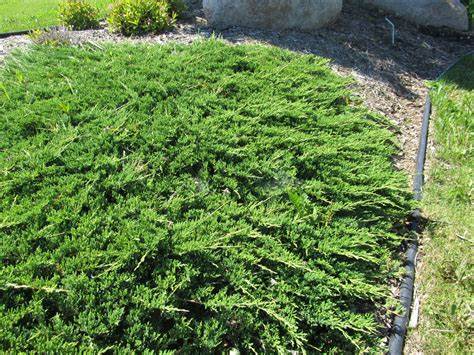Riverdene Garden Center
Prince of Wales Juniper
Prince of Wales Juniper
Couldn't load pickup availability
Juniperus × ‘Prince of Wales’
Prince of Wales Juniper is a low-growing, ground-hugging evergreen shrub known for its dense, spreading habit, bright green summer foliage, and purplish-bronze winter color. It is extremely cold-hardy (Zone 2-7), drought-tolerant, and low-maintenance, making it an excellent ground cover for prairie landscapes, slopes, rock gardens, and erosion control in Southwest Saskatchewan.
This juniper variety is one of the best groundcover evergreens due to its hardiness, adaptability, and weed-suppressing qualities.
Planting & Location
- Hardiness Zone: 2-7 (excellent for harsh prairie winters)
- Mature Size: 6-8 inches tall, 5-6 feet wide
- Growth Rate: Moderate (6-12 inches per year)
- Sunlight Needs: Full sun (6+ hours per day for best growth and color)
-
Soil Preference:
- Prefers well-drained, sandy or loamy soil.
- Tolerates rocky, alkaline, and clay soils if drainage is good.
- Avoid standing water or heavy clay soils, which can cause root rot.
- Spacing: 4-6 feet apart for groundcover, 8+ feet apart for individual plantings.
Watering
- Young Plants (First 1-2 Years): Water deeply once per week to establish roots.
- Established Plants: Drought-tolerant; water every 2-3 weeks in dry conditions.
- Avoid Overwatering: Prefers dry to medium moisture levels—too much water can cause root rot.
Fertilizing
- First Year: No fertilizer needed—focus on root establishment.
-
Mature Plants:
- Apply a slow-release evergreen fertilizer (e.g., 10-10-10) in early spring if growth is slow.
- Organic alternative: Compost or well-rotted manure in spring.
Pruning & Maintenance
- Minimal pruning required—naturally maintains a low, spreading shape.
- Best Time to Prune: Early spring, before new growth starts.
-
How to Prune:
- Remove dead or damaged branches if needed.
- Light trimming can encourage denser growth but avoid excessive cutting.
Pest & Disease Management
Highly resistant to pests and diseases, but minor issues can occur.
Common Pests:
-
Spider Mites – Cause yellowing needles in hot, dry weather.
- Solution: Hose off with water or use insecticidal soap.
-
Scale Insects – Small, waxy pests on stems.
- Solution: Treat with horticultural oil.
Common Diseases:
-
Cedar-Apple Rust (Gymnosporangium spp.) – Causes orange galls in spring.
- Solution: Remove infected areas and avoid planting near apple trees.
-
Root Rot (Phytophthora, Armillaria) – A risk in poorly drained soil.
- Solution: Ensure well-draining soil and avoid overwatering.
Winter Protection
- Extremely winter-hardy—does not need special protection.
- Winter Color Change: Foliage may turn purplish-bronze in winter, which is normal and adds seasonal interest.
- Mulching: Apply 2-4 inches of mulch around the base (not touching the stems) to insulate roots.
Landscape Uses
Excellent ground cover for slopes, rock gardens, and erosion control
Low-maintenance, drought-resistant, and cold-hardy
Weed-suppressing and helps with soil stabilization
Works well in mixed borders, foundation plantings, and mass plantings
Adds winter interest with its purplish foliage change
Additional Notes:
- Prince of Wales Juniper is one of the best evergreen groundcovers for cold, dry regions, requiring minimal care once established.
- Lifespan: 50+ years with proper care.
- Works well as a border plant, cascading over walls, or in xeriscapes.
Photo courtesy of Jeffries Nurseries
Share


